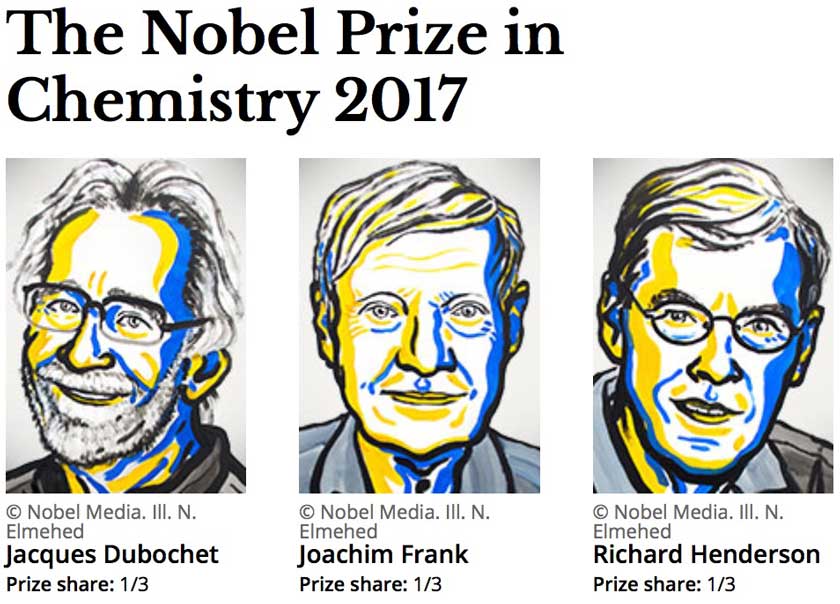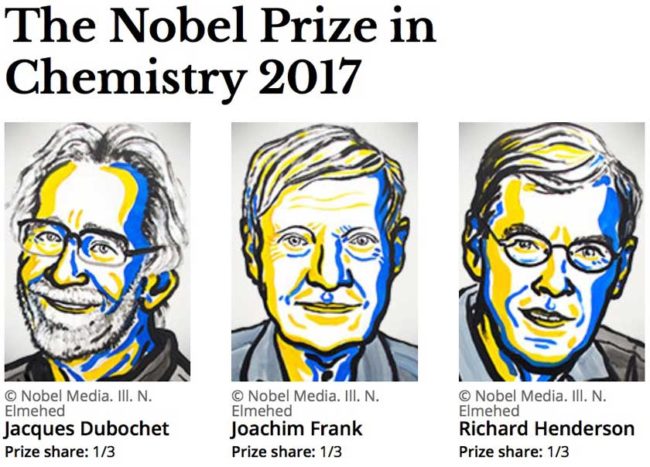The Royal Swedish Academy of Sciences has decided to award the Nobel Prize in Chemistry 2017 to
Jacques Dubochet
University of Lausanne, Switzerland
Joachim Frank
Columbia University, New York, USA
and
Richard Henderson
MRC Laboratory of Molecular Biology, Cambridge, UK
“for developing cryo-electron microscopy for the high-resolution structure determination of biomolecules in solution”
Like its twin the Physics Prize, Chemistry has a few well-known names of past winners such as Ernest Rutherford, Linus Pauling, and also Marie Curie (who also won the Physics prize in 1903, hence she is rather unique in that she has received two Nobels, and also her daughter Irene went on to win a Nobel prize as well). However, there are two observations that make the Chemistry award rather different.
The first is infamous. In 1919 they awarded the 1918 prize to Fritz Haber for the Haber-Bosch process, which sounds fine because that helped to feed the world. Unfortunately this was the same guy who was the “father of chemical warfare” and so had spent the previous few years out on the battlefront quite literally slaughtering vast numbers of people. To label this “controversial” does not even begin to describe the reactions at the time, and even to this day the Nobel page description of him brushes most of this under the carpet and does not mention it. He was a very complex character.
The fascinating bit, the part that is wholly appropriate in the context of 2017, is that often in the past decade or two, they have been granting the Chemistry award for things that are not actually Chemistry at all but instead biology. For example, 2015 for DNA repair, 2012 for G-protein-coupled receptors, and 2009 for ribosome. Why is Chemistry not actually for just Chemistry? Well basically because the Nobel awards are constrained by Nobel’s will and so they need to run things within that remit, yet also widen the scope a bit to reflect what is actually happening in science today.
So again now in 2017 the award is once again within the context of Molecular Biology and not strictly Chemistry at all.
(Details below have been grabbed from the official press release)
Who are the winners this year?
They are Biologists and not Chemists.
Jacques Dubochet, born 1942 in Aigle, Switzerland. Ph.D. 1973, University of Geneva and University of Basel, Switzerland. Honorary Professor of Biophysics, University of Lausanne, Switzerland.
Joachim Frank, born 1940 in Siegen, Germany. Ph.D. 1970, Technical University of Munich, Germany. Professor of Biochemistry and Molecular Biophysics and of Biological Sciences, Columbia University, New York, USA.
Richard Henderson, born 1945 in Edinburgh, Scotland. Ph.D. 1969, Cambridge University, UK. Programme Leader, MRC Laboratory of Molecular Biology, Cambridge, UK.
What did they do to be granted this award?
Cool microscope technology revolutionises biochemistry
(Side note: That is “cool” as in, very low temperatures, and is not simply telling you that it is very interesting)
We may soon have detailed images of life’s complex machineries in atomic resolution. The Nobel Prize in Chemistry 2017 is awarded to Jacques Dubochet, Joachim Frank and Richard Henderson for the development of cryo-electron microscopy, which both simplifies and improves the imaging of biomolecules. This method has moved biochemistry into a new era.
A picture is a key to understanding. Scientific breakthroughs often build upon the successful visualisation of objects invisible to the human eye. However, biochemical maps have long been filled with blank spaces because the available technology has had difficulty generating images of much of life’s molecular machinery. Cryo-electron microscopy changes all of this. Researchers can now freeze biomolecules mid-movement and visualise processes they have never previously seen, which is decisive for both the basic understanding of life’s chemistry and for the development of pharmaceuticals.
Electron microscopes were long believed to only be suitable for imaging dead matter, because the powerful electron beam destroys biological material. But in 1990, Richard Henderson succeeded in using an electron microscope to generate a three-dimensional image of a protein at atomic resolution. This breakthrough proved the technology’s potential.
Joachim Frank made the technology generally applicable. Between 1975 and 1986 he developed an image processing method in which the electron microscope’s fuzzy twodimensional images are analysed and merged to reveal a sharp three-dimensional structure.
Jacques Dubochet added water to electron microscopy. Liquid water evaporates in the electron microscope’s vacuum, which makes the biomolecules collapse. In the early 1980s, Dubochet succeeded in vitrifying water – he cooled water so rapidly that it solidified in its liquid form around a biological sample, allowing the biomolecules to retain their natural shape even in a vacuum.
Following these discoveries, the electron microscope’s every nut and bolt have been optimised. The desired atomic resolution was reached in 2013, and researchers can now routinely produce three-dimensional structures of biomolecules. In the past few years, scientific literature has been filled with images of everything from proteins that cause antibiotic resistance, to the surface of the Zika virus. Biochemistry is now facing an explosive development and is all set for an exciting future.
Read more about this year’s prize
- Popular Information – Pdf 2.7 MB
- Scientific Background – Pdf 837 Kb
- Image – 3D structures (pdf 1.4 MB) – © Johan Jarnestad/The Royal Swedish Academy of Sciences
- Image – Blobology (pdf 8.5 MB) – © Martin Högbom/The Royal Swedish Academy of Sciences
- Image – Dubochet’s preparation method (948 kB) – © Johan Jarnestad/The Royal Swedish Academy of Sciences
- Image – Frank’s image analysis (pdf 1 MB) – © Johan Jarnestad/The Royal Swedish Academy of Sciences

